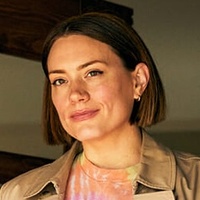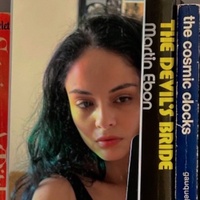On respecting yourself
Prelude
Eloghosa Osunde makes art across mediums because they are free. They are also the author of two critically acclaimed, award-winning novels: Vagabonds! and Necessary Fiction.
Conversation
On respecting yourself
Writer and artist Eloghosa Osunde discusses circular time, trusting their intuition, and processing life through creative mediums.
As told to Mary Retta, 1915 words.
Tags: Writing, Beginnings, Inspiration, Adversity, Identity, Multi-tasking, Mental health.
Both of your novels have enormous casts of characters. Necessary Fiction even has a list of them at the top of the book so readers can keep track. How do you come up with these characters? What’s the process?
This varies per book. Most of the time, I’m not actually coming up with the characters. With Necessary Fiction, the protagonist of “Good Boy”—the story that opens and propels the novel—came to me first in 2020 in the form of a short story which quickly went viral once published by The Paris Review. At the time, there were things I needed in my life and couldn’t figure out the words for—prayers for a certain type of community that I’d been whispering to god about and releasing into my journal. Then one late afternoon, I sat up in bed and wrote the first few sentences. Five hours later, that entire story was done. I didn’t come up with him, really; he entered my mind and life when I needed him, and that changed me. Because it was a standalone short story at first, I thought it was a one-off interaction. But he returned again in late 2022 one evening when I was driving. I’d say that the most crucial part of character work for me is staying spiritually open, and listening. The cast of Necessary Fiction showed up that way.
Both Vagabonds! and Necessary Fiction deal with questions of found family and community. What draws you to these themes in your writing?
Life. Necessary Fiction could only happen because myself, and the people in my life, were working through these themes in our personal lives. When it comes to community, I’m drawn to the idea of reinvention, of strategic insistence, of recreating the core foundations of a life if need be. I like that a new, glorious way of being can sprout out of hard ground and deep pain. My characters remind me and my readers that it is doable. Gruelling yes, but not impossible. You can choose, I can choose, we can choose. The characters show that across both books, and they uplift me that way.
Your novels often play with time in really creative and interesting ways. What draws you to a non-linear story structure?
Writing with the understanding that queer time is real, is serious, is meaningful, is how I keep making work that makes me feel free. Sometimes people read my novels and then they say things like, “There was no plot,” by which they mean there is no conventional story arc. But there are multiple plots at once coexisting within the text—multiple points of conflict and friction. The plots are circular because that’s how I see time. And the repetitions deepen each meaning. The way I write sometimes is that I prioritize a relationship or a series of characters over a continuous flow of story over 300-plus pages.
Sometimes, for me, the base question of a story isn’t what happened and in what span of time. Instead it is, why is this character like this? And sometimes the answer is that something happened once, and from within that occurrence, this person dreamt up who they would be. When they fail at being that person, they react this way—now let that unfold. The story makes it clear what’s salient and I choose that every time, because ultimately I’m not going to leave what I’m curious about for the sake of chronology. My stories understand time to be more complex than a straight line, and I’m grateful to be able to make work that can both contemplate and transcend time.
You are not just a writer, but an artist working with film, fashion, and more. How did you get involved in so many different mediums and how do you balance all of your creative pursuits?
I met them all at different stages. Writing when I was 6, photography when I was 16, art when I was 20, etc. I think the most accurate way to describe my practices is by using the word “maker.” For quite a while, I used to try to clarify that I’m a writer first, and everything else springs out of that. But time has worked on that understanding as well. I’m not a writer who also makes art. I’m a maker—the spirit behind the work—who can turn any intangible idea into something with solid form, through the act of applying myself to it. I’m more loyal to my calling than I am to any medium.
How do ideas take shape in your brain ? Do themes come first, or plot, or character?
Definitely themes tend to come first for me. Themes and rhythm. Once I can figure those two out, I have a shape. The rest is sketching and filling in.
How did you come up with the ideas for your two novels? Were the processes different?
The processes were definitely different. With Vagabonds! being my debut and my first attempt at writing a novel as myself, I followed the links that kept on appearing between sections. When characters from one story showed up in another, I simply allowed them. I figured that at the end of the process, I’d have something that made sense. And I did in the end. There was a lot more feeling around with that one and it paid off big time—to just trust. With Necessary Fiction, the book came out of the three questions that begin the synopsis: What makes a family? How is it defined and by whom? Is freedom for everyone? I was thinking about that from a place of personal curiosity. Meeting the characters, I paid close attention to how they responded, what answers they gave.
Writing Necessary Fiction was more demanding in every sense of the word. It wasn’t just creative work, it was also spiritual work. Healing work. All the paths the book took me through to find the answers I started out with and was looking for, they told on me. This one almost broke my health. But on the other side of it, I have the hard-won clarity I have been needing, and more grace, more mercy for myself.
What does a day-to-day or week-to-week look like for you, creatively? Does it look different when you are actively writing a book?
When I’m not writing or traveling, I sleep a lot. Like, a whole lot. Sleep is a happy place for me. My days are less intense when I’m not working on a book, and I’m always grateful for those seasons. My routines don’t change drastically. I’m still nocturnal, for instance; I still do most of the same things. I just feel lighter in my body after completing something, so I’m more present and more aware of my surroundings. I feel joy more vividly. When I’m working on something, sometimes it’s hard for me to see how much of myself I powered down in order to concentrate. When I’m done—when the work has its own body—I definitely feel more room within myself to just be. I feel like I can catch up on all the things I missed: art shows, tv shows, puzzles, coloring books, etc. I’ve been doing a lot of that now, even while on tour.
What are your thoughts on work-life balance as a creative person? Do you ever turn your creative brain off and if so how?
You know, I’m not sure I have a separate creative brain. I see everything and process everything through the mind I make my work from. The way I rest when I’m actively bringing something to life is by focusing my brain on multiple outlets. It helps me to do more instead of less. If I’m working on a novel or an installation or a painting, it’s really important that I don’t think of that mind as something to put down, but as something that can focus on various things. Some of those have to be replenishing so that I can breathe well. When I’m done writing for the day, I turn my attention to a long drive with a playlist I made, or a meal I’ve been wanting to try cooking. I do jigsaw puzzles, play games, watch a film, write a song, spend time with my person or a friend. That’s what rest looks like for me: playing with my abilities, pleasure seeking. Oh, and dancing.
Do you treat your art practice like a business? How did you figure out how to make a living through your creative work?
I give my team all the credit for helping me with the business of art. My agents are incredible at helping me figure out what is worth taking on and what’s just not. Those parts didn’t occur to me naturally at first. I’m better now but still need help. So I’m grateful to have a team who know what they’re doing and who are fierce in their protection of my interests. If I’m to make art full time, which I decided I always will, I have to consider what it takes to sustain the life I live. There are always bills to pay, daily demands on my time and resources. My agent found me pretty early on in the process and signed me based on one essay and one short story. I’ll always be thankful for that because it made it possible for me to start building a sustainable structure even before I had a book out. Having someone be an email away at all times definitely made my journey less painful.
What’s something you wish you had known when you were first starting out as a writer and artist?
Study is important, but I think to make great art, you also have to respect your own mind and intuition. Something I wish I had known when I first started is that the way my brain works is an asset. If I had known that, I wouldn’t have struggled so much in the beginning, believing that I couldn’t write a novel. How I think isn’t a curse just because it doesn’t look like what is taught in MFAs as the ideal way to write. It’s a strength, actually. Learning to respect your mind and how it works is inner work, and the more I learn that, the more it changes everything. Leaning into my pleasures and delights saved my work. Giving myself permission to prioritize what I like to see in art over what I was taught to value because it is the “right way to do it” is what changed everything for me. It’s what makes my art possible.
Eloghosa Osunde recommends:
Self regard.
Listening to Doechii’s Alligator Bites Never Heal and playing Angry Birds thousands of kilometers above sea level while getting a back massage in your seat. I recently experienced this on a long-haul flight where I also ate honeycomb, a great seafood salad, the perfect poached egg on a bed of spinach, and a salmon rose. Mind bending.
The Four Seasons on Netflix. I love Colman Domingo and enjoyed the pace of this show.
GoodGirl LA’s recent EP, Goodgirl. She’s onto something.
This line by poet Yusef Komunyakaa: “If you must quote me, remember. I said that love heals from the inside,” for its gentle, concise wisdom.
- Name
- Eloghosa Osunde
- Vocation
- writer, artist, maker
Some Things
Pagination



